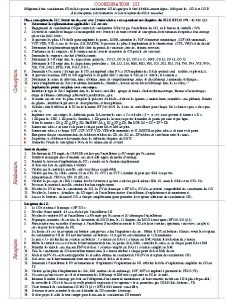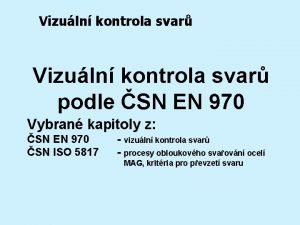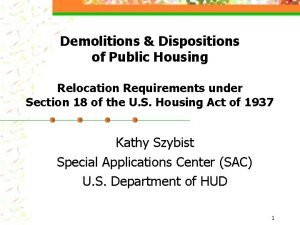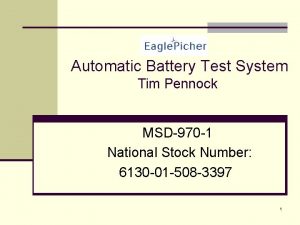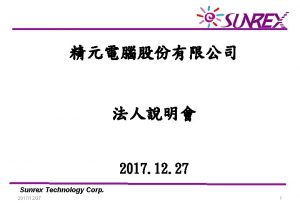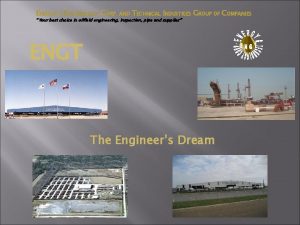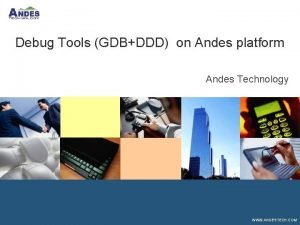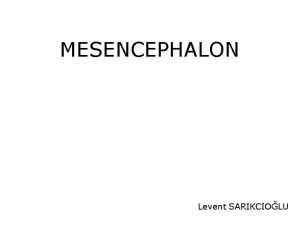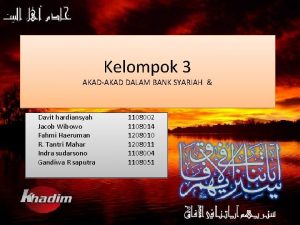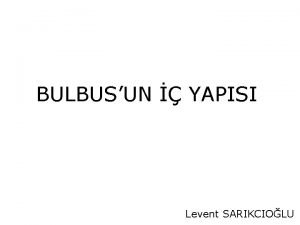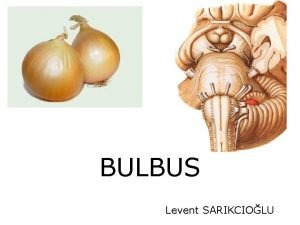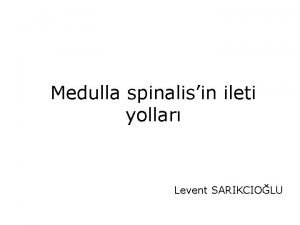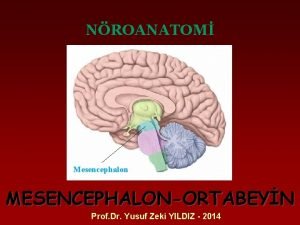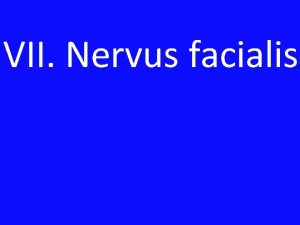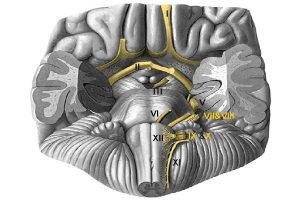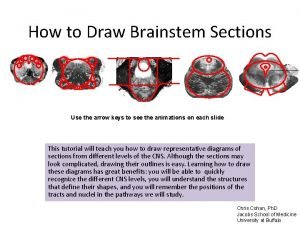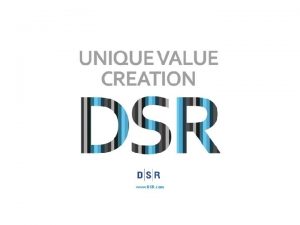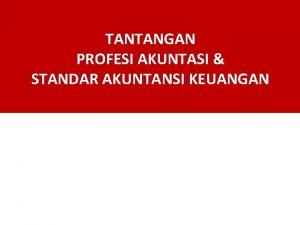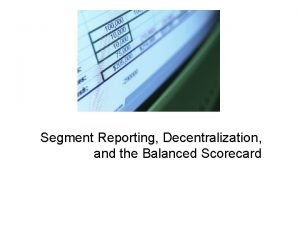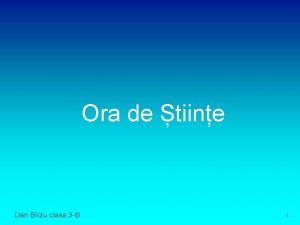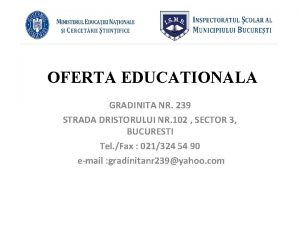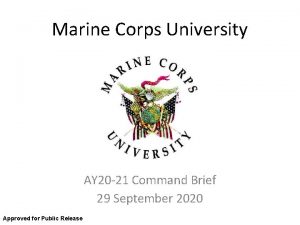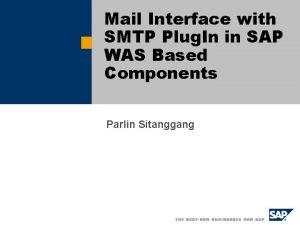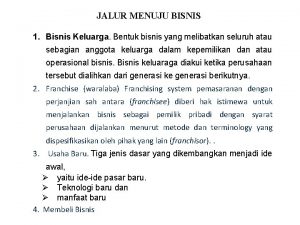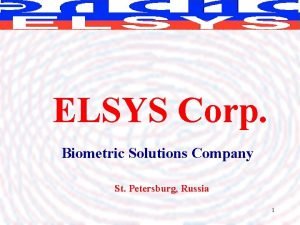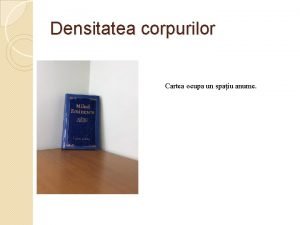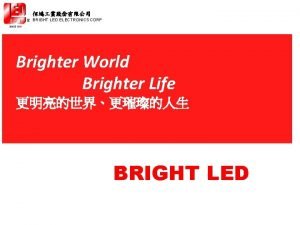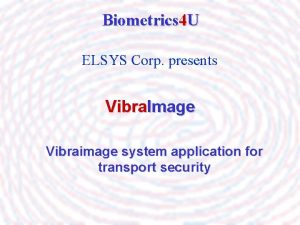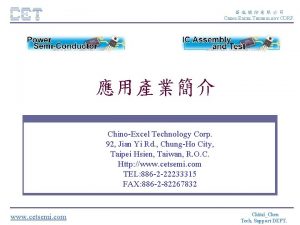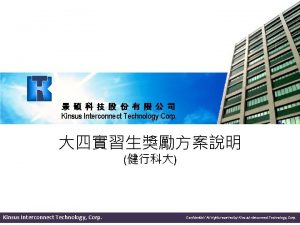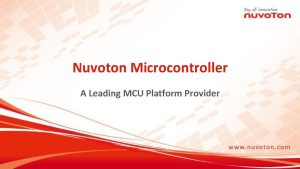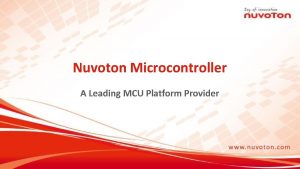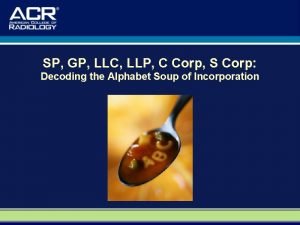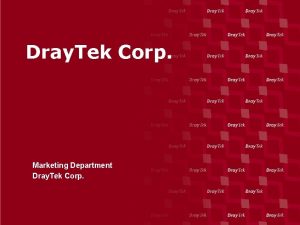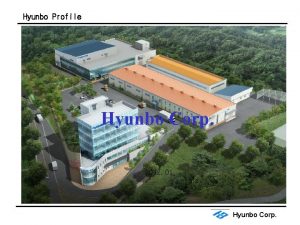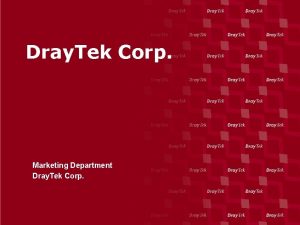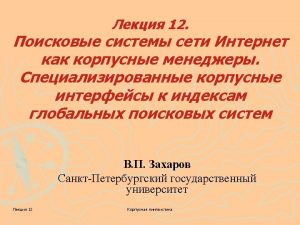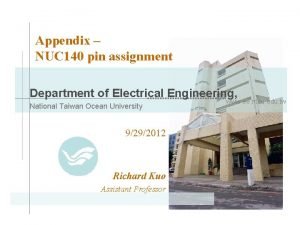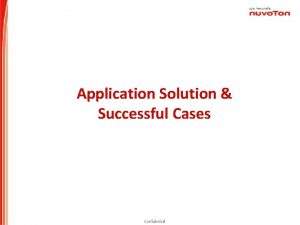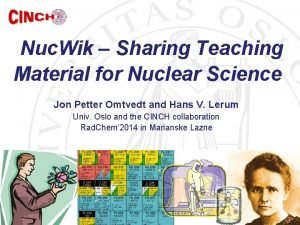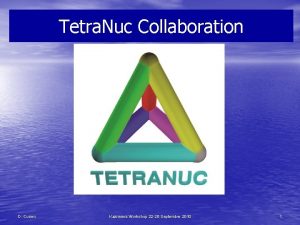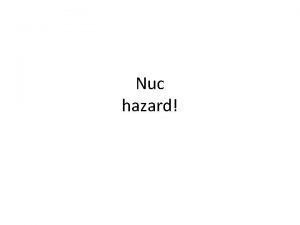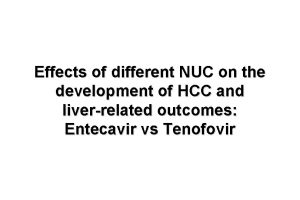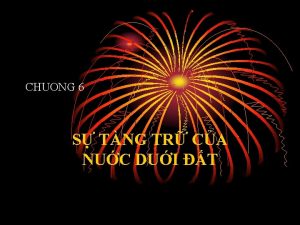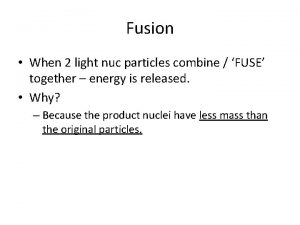NUC 970 Jan 27 2015 Nuvoton Technology Corp





































- Slides: 37

NUC 970 Jan. 27, 2015 Nuvoton Technology Corp.

Power on setting Power-On Setting Pin Description USB 0_ID USB Port 0 Role Selection PA[1: 0] 0 = USB Port 0 act as a USB host. ; 1 = USB Port 0 act as a USB device. Boot Source Selection 00 = Boot from USB; 01 = Boor from e. MMC. PA. 2 10 = Boot from NANA Flash; 11 = Boot from SPI Flash. System Clock Source Selection PA. 3 0 = System clock is from 12 MHz crystal; 1 = System clock is from UPLL output. Watchdog Timer (WDT) ON/OFF Selection PA. 4 0 = WDT is OFF after power-on; 1 = WDT is ON after power-on. JTAG Interface ON/OFF Selection PA. 5 0 = Pin PJ[4: 0] used as GPIO pin; 1 = Pin PJ[4: 0] used as JTAG interface. UART 0 Debug Message Output ON/OFF Selection 0 = UART 0 debug message output ON; 1 = UART 0 debug message output OFF. Power-On Setting Register Bit PWRON[16] PWRON[1: 0] PWRON[2] PWRON[3] PWRON[4] PWRON[5] NAND Flash Page Size selection PA[7: 6] 00 = NAND Flash page size is 2 KB; 01 = NAND Flash page size is 4 KB. PA[9: 8] 10 = NAND Flash page size is 8 KB; 11 = Ignore Power-On Setting. NAND Flash ECC Type Selection 00 = NAND Flash ECC type is BCH T 12; 01 = NAND Flash ECC type is BCH T 15. PWRON[7: 6] PWRON[9: 8] 10 = NAND Flash ECC type is BCH T 24; 11 = Ignore Power-On Setting. Internal pull up (50 K) while RESET period USB 0_ID, Mater/Slave role can be changeable by this pin 2

System Memory Map 3

Memory MAP. Addressing Space Token Modules SDRAM, External Devices and SRAM Memory Space 0 x 0000_0000 – 0 x 2 FFF_FFFF SDRAM_BA SDRAM and External Devices Memory Space 0 x 3 C 00_0000 – 0 x 3 C 00_CFFF SRAM_BA SRAM Memory Space (56 KB) Internal Boot ROM (IBR) Memory Space (0 x. FFFF_0000 ~ 0 x. FFFF_3 FFF) IBR_BA 0 x. FFFF_0000 – 0 x. FFFF_3 FFF Internal Boot ROM (IBR) Memory Space (16 KB) 4

AHB Reg. MAP AHB Modules Memory Space (0 x. B 000_0000 – 0 x. B 7 FF_FFFF) 0 x. B 000_0000 – 0 x. B 000_01 FF SYS_BA System Global Control Registers 0 x. B 000_0200 – 0 x. B 000_02 FF CLK_BA Clock Control Registers 0 x. B 000_1000 – 0 x. B 000_17 FF EBI_BA EBI Control Registers 0 x. B 000_1800 – 0 x. B 000_1 FFF SDIC_BA SDRAM (SDR/DDR 2) Control Registers 0 x. B 000_2000 – 0 x. B 000_2 FFF EMAC 0_BA Ethernet MAC 0 Control Registers 0 x. B 000_3000 – 0 x. B 000_3 FFF EMAC 1_BA Ethernet MAC 1 Control Registers 0 x. B 000_4000 – 0 x. B 000_4 FFF GDMA_BA GDMA Control Registers 0 x. B 000_5000 – 0 x. B 000_5 FFF EHCI_BA USB EHCI Host Control Registers 0 x. B 000_6000 – 0 x. B 000_6 FFF USBD_BA USB Device Control Registers 0 x. B 000_7000 – 0 x. B 000_7 FFF OHCI_BA USB OHCI Host Control Registers 0 x. B 000_8000 – 0 x. B 000_8 FFF LCD_BA LCD Display Control Registers 0 x. B 000_9000 – 0 x. B 000_9 FFF I 2 S_BA I 2 S Interface Control Registers 0 x. B 000_A 000 – 0 x. B 000_AFFF JPEG_BA JPEG Codec Control Registers 0 x. B 000_B 000 – 0 x. B 000_BFFF GE 2 D_BA 2 D Graphic Engine Control Registers 0 x. B 000_C 000 – 0 x. B 000_CFFF SDIO_BA SD/SDIO Host Control Registers 0 x. B 000_D 000 – 0 x. B 000_DFFF FMI_BA Flash Memory Interface (FMI) Control Registers 0 x. B 000_E 000 – 0 x. B 000_EFFF VCAP_BA Video Capture (CMOS Sensor Interface) Control Registers 0 x. B 000_F 000 – 0 x. B 000_FFFF CRYPTO_BA Cryptographic Accelerator Control Registers 5

APB MAP APB Modules Memory Space (0 x. B 800_0000 ~ 0 x. BBFF_FFFF) 0 x. B 800_0000 – 0 x. B 800_00 FF UART 0_BA 0 x. B 800_0100 – 0 x. B 800_01 FF UART 1_BA 0 x. B 800_0200 – 0 x. B 800_02 FF UART 2_BA 0 x. B 800_0300 – 0 x. B 800_03 FF UART 3_BA 0 x. B 800_0400 – 0 x. B 800_04 FF UART 4_BA 0 x. B 800_0500 – 0 x. B 800_05 FF UART 5_BA 0 x. B 800_0600 – 0 x. B 800_06 FF UART 6_BA 0 x. B 800_0700 – 0 x. B 800_07 FF UART 7_BA 0 x. B 800_0800 – 0 x. B 800_08 FF UART 8_BA 0 x. B 800_0900 – 0 x. B 800_09 FF UART 9_BA 0 x. B 800_0 A 00 – 0 x. B 800_0 AFF UART 10_BA 0 x. B 800_1000 – 0 x. B 800_10 FF TIMER_BA 0 x. B 800_1400 – 0 x. B 800_14 FF ETIMER 0_BA 0 x. B 800_1500 – 0 x. B 800_15 FF ETIMER 1_BA 0 x. B 800_1600 – 0 x. B 800_16 FF ETIMER 2_BA 0 x. B 800_1700 – 0 x. B 800_17 FF ETIMER 3_BA 0 x. B 800_1800 – 0 x. B 800_18 FF WDT_BA 0 x. B 800_1900 – 0 x. B 800_19 FF WWDT_BA 0 x. B 800_2000 – 0 x. B 800_2 FFF AIC_BA 0 x. B 800_3000 – 0 x. B 800_3 FFF GPIO_BA 0 x. B 800_4000 – 0 x. B 800_4 FFF RTC_BA 0 x. B 800_5000 – 0 x. B 800_53 FF SC 0_BA 0 x. B 800_5400 – 0 x. B 800_57 FF SC 1_BA 0 x. B 800_6000 – 0 x. B 800_60 FF I 2 C 0_BA 0 x. B 800_6100 – 0 x. B 800_61 FF I 2 C 1_BA 0 x. B 800_6200 – 0 x. B 800_62 FF SPI 0_BA 0 x. B 800_6300 – 0 x. B 800_63 FF SPI 1_BA 0 x. B 800_7000 – 0 x. B 800_7 FFF PWM_BA 0 x. B 800_8000 – 0 x. B 800_8 FFF KPI_BA 0 x. B 800_A 000 – 0 x. B 800_AFFF ADC_BA 0 x. B 800_B 000 – 0 x. B 800_B 3 FF CAN 0_BA 0 x. B 800_B 400 – 0 x. B 800_B 7 FF CAN 1_BA 0 x. B 800_C 000 – 0 x. B 800_CFFF MTP_BA UART 0 Control Registers UART 1 Control Registers (High-Speed UART) UART 2 Control Registers (High-Speed UART) UART 3 Control Registers UART 4 Control Registers (High-Speed UART) UART 5 Control Registers UART 6 Control Registers (High-Speed UART) UART 7 Control Registers UART 8 Control Registers (High-Speed UART) UART 9 Control Registers UART 10 Control Registers (High-Speed UART) Timer Control Registers Enhance Timer 0 Control Registers Enhance Timer 1 Control Registers Enhance Timer 2 Control Registers Enhance Timer 3 Control Registers Watch-Dog Timer Control Registers Windowed Watch-Dog Timer Control Registers Advance Interrupt Control Registers GPIO Control Registers Real Time Clock (RTC) Control Registers Smart Card 0 Control Registers Smart Card 1 Control Registers I 2 C 0 Control Registers I 2 C 1 Control Registers SPI 0 Control Registers SPI 1 Control Registers PWM Control Registers KPI Control Registers ADC Control Registers CAN 0 Control Registers CAN 1 Control Registers MTP Control Registers (OTP) 6

Chip Block Diagram 7

NUC 970 Features (1) Core ARM® ARM 926 EJ-S™ processor core runs up to 300 MHz Support 16 KB instruction cache and 16 KB data cache Support MMU Support JTAG Debug interface External Bus Interface (EBI) Support SRAM and external I/O devices Support 8/16 -bit data bus width Up to 5 chip selects for SRAM or external I/O devices Programmable access cycle 4 x 32 -bit write buffers (Don’t support SDRAM & NOR) 8

NUC 970 Features (2) DDR SDRAM Controller Support DDR, DDR 2 and LPDDR SDRAM Speed Clock up to 150 MHz 16 -bit data bus width Two chip selects Memory size up to 256 M bytes (each chip select for 128 M bytes) Embedded SRAM and ROM Embedded 56 K bytes SRAM 16 K bytes Internal Boot ROM (IBR) Support 4 kinds of booting modes USB e. MMC NAND Flash SPI Flash 9

NUC 970 Features (3) Clock Control Two PLL, up to 500 MHz External 12 MHz crystal input for precise timing operation External 32. 768 k. Hz low speed crystal input for RTC function and low speed clock source Ethernet MAC Controller 2 Ethernet MAC controllers, Support IEEE Std. 802. 3 CSMA/CD protocol Support 10 and 100 Mbps; Half and Full duplex operations Support RMII interface to Ethernet PHY management through MDC and MDIO interface Support CAM-like function to recognize 48 -bit Ethernet MAC address Support Wake-On-LAN (WOL) by detecting Magic Packet Support 256 bytes transmit FIFO and 256 bytes receive FIFO, DMA function Support internal loop back mode for diagnostic 10

NUC 970 Features (4) USB 2. 0 Controller USB 2. 0 High-Speed (HS) Device/Host with embedded transceiver x 1 USB 2. 0 High-Speed (HS) Host with embedded transceiver x 1 Support Control, Bulk, Interrupt, Isochronous and Split transfers Support Enhanced Host Controller Interface (EHCI) 1. 0 specification to connect with USB 2. 0 High-Speed (HS) device. Support Open Host Controller Interface (OHCI) 1. 0 specification to connect with USB 1. 1 Full-Speed (FS) and Low-Speed (LS) devices Support USB device with 1 endpoint for Control IN/OUT transfers and 12 programmable endpoints for Bulk, Interrupt and Isochronous IN/OUT transfers Support suspend, resume and remote wake-up capability Support DMA function Support 2 K Bytes SRAM for USB host Support 4 K Bytes SRAM for USB device 11

NUC 970 Features (5) Flash Memory Interface Support NAND flash interface Support 8 -bit data bus width Support SLC and MLC type NAND flash device Support 512 B, 2 KB, 4 KB and 8 KB page size NAND flash device Support ECC 4, ECC 8, ECC 12, ECC 15 and ECC 24 BCH algorithm for ECC code generation, error detection and error correction. Support e. MMC flash interface Support DMA to accelerate transfer between memory and NAND and e. MMC I 2 S Controller I 2 S supports mono/stereo; record/playback; 8/16/20/24 -bit data; master/slave mode PCM supports 2 slots for 2 devices; 8/16/20/24 data; master mode Support four 8 x 24 (8 24 -bit) buffer for left/right channel record and left/right playback Support DMA to accelerate transfer between memory and internal buffer Support 2 buffer address for left/right channel and 2 slots data transfer 12

NUC 970 Features (6) LCD Display Controller Support 8/12/16/18/24 -bit data to connect 80/68 mode MPU type LCD Support resolution up to 2048 x 2048 Data format conversion for display output From RGB 444, RGB 565, RGB 666, RGB 888, YUV 422 and YUV 444 to RGB 444, RGB 565, RGB 666, RGB 888, YUV 422 and YUV 444 Support CCIR-656 with VSYNC, HSYNC and data enable sync signal, 8/16 -bit YUV data output to connect with external TV encoder Support 8/16 bpp OSD data with video overlay Support linear 1 X to 8 X image scaling up function Support Picture-In-Picture display function Support hardware cursor 13

NUC 970 Features (7) Capture (CMOS Sensor Interface) Support CCIR 601 & CCIR 656 interfaces to connect with CMOS image sensor Support resolution up to 3 M pixels Support YUV 422 and RGB 565 color format for data output by CMOS image sensor Support YUV 422, RGB 565, RGB 555 and Y-only color format for system memory Support planar and packet data format for data storing to system memory Support image cropping and the cropping window is up to 4096 x 2048 Support image scaling-down: Support vertical and horizontal scaling-down for preview mode Support N/M scaling factor where N < or = M Support 2 pairs of configurable 16 -bit N and 16 -bit M Two interlace-fields to a single frame for data output by TV-decoder. Support 3 color processing effects: Negative, Sepia & Posterization (海報化) 14

NUC 970 Features (8) 2 D Graphic Engine Support 2 D Bit Block Transfer (Bit. BLT) functions defined in Microsoft GDI Support Host, Pattern, Color/Font Expanding, Transparent, Tile, Block Move, Copy File BLT Support Color/Font Expansion, Rectangle Fill Support RGB 332/RGB 565/RGB 888 data format. Support fore/background colors and all Microsoft 256 ternary raster-operation codes (ROP) Support both inside and outside clipping function Support alpha-blending for source/destination picture overlaying Support fast Bresenham line drawing algorithm to draw solid/textured line 用來描繪由兩點所決定的直線 的演算法 Support rectangular border and frame drawing, picture re-sizing Support down-scaling from 1/255 to 254/255; up-scaling from 1 to 1. 996 (1+254/255) Support object rotation with different degree Support L 45 (45 degree left rotation) and L 90 (90 degree left rotation) Support R 45 (45 degree right rotation) and R 90 (90 degree right rotation) Support M 180 (mirror/flop) Support F 180 (up-side-down (flip) and X 180 (180 degree rotation) 15

NUC 970 Features (9) JPEG Codec Baseline Sequential mode, compliant with ISO/IEC 10918 -1 international JPEG standard Planar Format Support encode interleaved YCb. Cr 4: 2: 2/4: 2: 0 and gray-level (Y only) format image Support decode interleaved YCb. Cr 4: 4: 4/4: 2: 2/4: 2: 0/4: 1: 1 and gray-level (Y only) format image Support decode YCb. Cr 4: 2: 2 transpose format Support arbitrary width and height image encode and decode Support three programmable quantization-tables Support standard default Huffman-table and programmable Huffman-table for decode Support arbitrarily 1 X~8 X image up-scaling function for encode mode Support down-scaling function for encode and decode modes Support specified window decode mode Support quantization-table adjustment for bit-rate and quality control in encode mode Support rotate function in encode mode Packet Format Support encode interleaved YUYV format input image, output bit stream 4: 2: 2 and 4: 2: 0 format Support to decode interleaved YCb. Cr 4: 4: 4/4: 2: 2/4: 2: 0 format image Support decoded output image RGB 555, RGB 565 and RGB 888 formats. The encoded JPEG bit-stream format is fully compatible with JFIF and EXIF standards Support arbitrary width and height image encode and decode Support three programmable quantization-tables Support standard default Huffman-table and programmable Huffman-table for decode Support arbitrarily 1 X~8 X image up-scaling function for encode mode Support down-scaling function 1 X~ 16 X for Y 422 and Y 420, 1 X~ 8 X for Y 444 for decode mode Support specified window decode mode Support quantization-table adjustment for bit-rate and quality control in encode mode Support Scatter-Gather mode for output frame buffer 16

NUC 970 Features (10) Crypto Engine PRNG, Support 64 -bit, 128 -bit, 192 -bit and 256 -bit key generation DES Support FIPS 46 -3 Support both encryption and decryption Support ECB, CBC, CFB, OFB and CTR modes 3 DES Support FIPS NIST 800 -67 Implements according to the X 9. 52 standard Support 112 -bit and 168 -bit key Support both encryption and decryption Support ECB, CBC, CFB, OFB and CTR modes AES Support FIPS NIST 197 Support SP 800 -38 A & addendum Support 128 -bit, 192 -bit and 256 -bit key Support both encryption and decryption Support ECB, CBC, CFB, OFB , CTR, CBC-CS 1, CBC-CS 2 and CBC-CS 3 modes Support Key Expander SHA/HMAC Support FIPS NIST 180, 180 -1, 180 -2 Support SHA-160, SHA-224, SHA-256, SHA-384, SHA-512 and corresponding HMAC algorithm Support 128 -bit MTP key 17

NUC 970 Features (11) GDMA (General DMA) Support 2 channels GDMA for memory-to-memory data transfer without CPU intervention Support increment and decrement for source and destination address calculation Support 8 -bit, 16 -bit and 32 -bit width data transfer Support four 8 -bit/16 -bit/32 -bit burst transfer UART Support up to 11 UART controllers Support 1 UART (UART 1) with full model function (TXD/RXD/CTS/RTS/CDn/Rin/DTR/ DSR) and 64 -byte FIFO Support 5 UART (UART 2/4/6/8/10) with flow control (TXD/RXD/CTS/RTS) and 64 -byte FIFO Support 5 TXD/RXD only UART ports (UART 0/3/5/7/9) with 16 -byte FIFO for standard device Support Ir. DA (SIR) and LIN function Support RS-485 9 -bit mode and direction control Support programmable baud-rate generator up to 1/16 system clock 18

NUC 970 Features (12) C-CAN Supports CAN protocol version 2. 0 part A and B Bit rates up to 1 M bit/s 32 Message Objects, each Message Object has its own identifier mask Programmable FIFO mode (concatenation of Message Object) Maskable interrupt Disabled Automatic Re-transmission mode for Time Triggered CAN applications Support power down wake-up function Smart Card Host (SC) Compliant to ISO-7816 -3 T=0, T=1, two ports Separate receive / transmit 4 bytes entry FIFO for data payloads Programmable transmission clock frequency Programmable receiver buffer trigger level Programmable guard time selection (11 ETU ~ 266 ETU) One 24 -bit and two 8 -bit time-out counters for Answer to Request (ATR) and waiting times processing Supports auto inverse convention function Supports transmitter and receiver error retry and error limit function Supports hardware activation sequence process Supports hardware warm reset sequence process Supports hardware deactivation sequence process Supports hardware auto deactivation sequence when detecting the card removal 19

NUC 970 Features (13) Timer Support 5 sets of 32 -bit timers with 24 -bit up-timer and one 8 -bit pre-scale counter Independent clock source for each timer Support one-shot, periodic, toggle and continuous operation modes Enhanced Timer Support 4 sets of 32 -bit timers with 24 -bit up-timer and one 8 -bit pre-scale counter Independent clock source for each timer Support one-shot, periodic, toggle and continuous operation modes Supports external pin capture for interval measurement Supports external pin capture for timer counter reset Watchdog Timer Multiple clock sources 8 selectable time out period from 1. 6 ms ~ 26. 0 sec (depends on clock source) WDT can wake-up from power down or idle mode Interrupt or reset selectable on watchdog timer time-out Windowed-Watchdog Timer 6 -bit down counter with 11 -bit pre-scale for wide range window selected Interrupt on windowed-watchdog timer time-out Reset on windowed-watchdog timer time out or reload in an unexpected time window 20

NUC 970 Features (14) Real Time Clock (RTC) Supports software compensation by setting frequency compensate register (FCR) Supports RTC counter (second, minute, hour) and calendar counter (day, month, year) Supports Alarm registers (second, minute, hour, day, month, year) Selectable 12 -hour or 24 -hour mode Automatic leap year recognition Supports periodic time tick interrupt with 8 period options 1/128, 1/64, 1/32, 1/16, 1/8, 1/4, 1/2 and 1 second Supports battery power pin (VBAT) Supports wake-up function PWM Built-in up to two 16 -bit PWM generators provide four PWM outputs Each PWM generator equipped with one clock source selector, one clock divider, one 8 -bit pre-scale, two 16 -bit counters, and one Dead-Zone generator 21

NUC 970 Features (15) SPI Built-in up to two sets of SPI controller Support SPI master mode Support single/dual/quad bit data bus width Full duplex synchronous serial data transfer Variable length of transfer data from 8 to 32 bits MSB or LSB first data transfer Burst mode operation that transmission and reception can be executed up to 4 times in a transfer Support 2 slave/device select lines I 2 C Two sets of I 2 C engines support master mode Bidirectional data transfer between masters and slaves Multi-master bus (no central master) Arbitration between simultaneously transmitting masters without corruption of serial data on the bus Serial clock synchronization allows devices with different bit rates to communicate via one serial bus Serial clock synchronization can be used as a handshake mechanism to suspend and resume serial transfer Programmable clocks allow versatile rate control Support software mode to generate I 2 C signaling 22

NUC 970 Features (16) Advanced Interrupt Controller Support 58 interrupt sources, including 8 external interrupt sources Support programmable normal or fast interrupt mode (IRQ, FIQ) Support programmable edge-triggered or level-sensitive for 8 external interrupt sources Support programmable low-active or high-active for 8 external interrupt sources Support encoded priority methodology to allow for interrupt daisy-chaining Support lower priority interrupt automatically mask out for nested interrupt Support to clear interrupt flag automatically if interrupt source is programmed as edge-triggered GPIO TTL/Schmitt trigger input selectable I/O pin can be configured as interrupt source with edge/level setting Support pull-up and pull-down control ADC 12 -bit SAR ADC with 1 M/200 K SPS Up to 8 -ch single-end input Support 4 -wire or 5 -wire resistance touch screen interface Support touch pressure (Z) measurement for 4 -wire touch screen application Support pen down detection Support battery measurement Support keypad scan 23

NUC 970 Features (17) KPI ( It cannot be shared with LCD) Matrix keypad interface supported. Maximum 4 X 8 and minimum 3 X 3 keypad matrix supported. Configurable key de-bounce supported. Low power wakeup mode supported. Configurable three-key reset supported. MTP (OTP) Support 256 -bit programmable memory for key of Crypto functionality Support up to 15 times of programming and erase. TIC (it can support MTP programming) SPI-Like slave interface supported for test purpose. 1 -bit, 2 -bit and 4 -bit data width supported. Single and burst (four 32 -bit data) data access supported. DTS only, don’t release in TRM 24

NUC 970 Features (18) Low Voltage Detect and Reset (VSI IP) Support two, 2. 6 V and 2. 8 V, voltage detection levels Interrupt when low voltage detected Reset when low voltage detected Low Voltage Reset threshold voltage levels: 2. 4 V Operating Voltage 1. 2 V for core logic operating 1. 8 V/2. 5 V/3. 3 V for DDR 2/DDR/SDR SDRAM I/O operating 3. 3 V for normal I/O operating Operating Temperature: -40℃~85℃ Packages: All Green package (Ro. HS) LQFP 216 -pin LQFP 128 -pin 25

PKG Naming Rule 26

Key Components Function 1 RS 232 2 CAN 3 4 IIS Key SW LCD 6 7 NAND JTAG ICE 8 Ethernet 10 SD 11 USB host 12 USB device 13 CMOS sensor 14 e. MMC 17 Battery 18 19 Smart card SPI flash Key Material pcs/board TRS 3232 EC Female connector Ti SN 65 HVD 230 3. 3 -V CAN TRANSCEIVERS Connector NAU 8822 L Tack switch Panel, E 50 A 2 V 1 5” with TP (800 x 480) 40 -pin, bottom Winbond, 1 G Multi-ICE 10 x 2 pins DIN connector a). EMAC PHY, IC+ 101 GR b). RJ 45 w LED c). Transformer Normal STD SD slot a). Host TYP A connector b). USB 5 V Power OCP, APL 3511 A Mini. B Device connector NT 99141, 720 P FPC 24 -pin w/ Bottom side. ASi. P NCMMCA 04 A CR 2032 battery paddle Smart card slot Winbond SPI 16 MB Flash Note 6 5 2 2 1 32 1 1 1 1 1 Temprary 27

NUC 970 Internal Block Diagram 28

NUC 970 Series Function NUC 976 NUC 977 NUC 972 NUC 973 PKG LQFP 128 LQFP 216 EBI x x V V SAR_ADC TP(4) x TP(4/5)+AIN(4/3) TP(4)+AIN(1) NAND x V Video CAP V V USBH+USBD V V SPI 0(4 -bit) SPI 1(1 -bit) SPI 0(4 -bit) two CS SPI 1(1 -bit) two CS SPI 0(4 -bit)two CS SPI 1(4 -bit)two CS LCD 16 -bit 24 -bit Smartcard SMCx 2 CANx 1 CANx 2 LAN RMIIx 1 RMIIx 2 UART Port 0, 6, 8 &10 Port 0, 5, 6, 7, 8 & 10 All-11 SD 2 ports e. MMC (4 -bit) V V I 2 C 2 2 I 2 S V V KPI 4 x 8 RTC V V Application 2 D-Bar code/ finger Printer HMI/ Industrial Power Meter POS 29

電氣特性 – EFT-Electrical Fast Transients Follow IEC 61000 -4 -4 30

Nuvoton MCU EFT Test Environment Keytek EMCpro DC 5 V Couple EFT Noise DC 5 V Follow IEC 61000 -4 -4 31

NUC 972 EFT Test Pass Level 32

和可靠度相关的电气特性 – Chip ESD 3 种不同的 Chip ESD HBM (Human-Body Model) 2000 V MM (Machine Model) 200 V 0 V CDM (Charged-Device Model) 500 V 0 V 0 V 33

Chip ESD 和 System ESD 是不一样的规格 标准不同 Chip ESD: HBM MIL-STD-833 C, MM: EIA/JESD 22 -A 115 -A System ESD: IEC 61000 -4 -2 应用场合不同 Chip ESD: 芯片未上电, 应用于生产, 运送中的保护 System ESD: 芯片上电, 应用于实际 作状态 能量等级不同 Chip ESD: HBM 2 KV, MM 200 V 是一般 IC level System ESD Level 4: Contact Mode 8 KV, Air Mode 15 KV System ESD 只靠MPU檔不住, 需外部保護元件 Under 8 -k. V ESD zapping, the peak current in system-level ESD test is about 5 ~ 6 times larger than that in component-level ESD test 34

System Diagram 12 MHz PC communication XTAL 32 k. Hz RTC ICE debugging JTAG IF USBH/D 2. 0 UART x 11 USBH 2. 0 KPI EMACx 2 (RMII) RGB 888/666/565 Resistive Touch Backlight Control 24 -bit LCD IISx 1 NUC 972 TP (4 -W/5 -W) PWMx 4 IICx 2 Key matrix NAU 8822 L CAN bus CAN x 2 Video In SIM card CMOS Sensor SD/SDIO RTC_VDD e. MMC I SP sh a Fl NAND Flash EBI device NAND SPI Memory Storage/ security IO@3. 3 V; Core@1. 2 V; MVDD@1. 8 V Power Adaptor 35

NUC 970 System Power Scheme LDO BAT 3. 3 V DC-IN Core 1. 2 V (PLL) RTC_3. 3 V USBPLL 0_1. 2 V USB-PWR Core 1. 2 V USBPLL 1_1. 2 V RTC_WKUP Power ON/OFF NUC 972 Vin USB 0_3. 3 V IO 3. 3 V USB 1_3. 3 V SAR_ADC_3. 3 V DDR 2 MVDD 1. 8 V IO 3. 3 V USBH port 5 V LCM Backlight Booting Device Peripheral 36

37
 Fiberfrax 970
Fiberfrax 970 Nf s 61 970
Nf s 61 970 Landoltovy kruhy
Landoltovy kruhy 24 cfr 970
24 cfr 970 Msd-970
Msd-970 Fiberfrax 970
Fiberfrax 970 Sunrex technology corp
Sunrex technology corp Technical industries inc
Technical industries inc Andes technology corp
Andes technology corp Arabeyin
Arabeyin Tegmentum mesencephali
Tegmentum mesencephali Perbedaan nuc dan ncc
Perbedaan nuc dan ncc Uvula cerebellum
Uvula cerebellum Tegmentum pontis
Tegmentum pontis Sulcus retroolivaris
Sulcus retroolivaris Nuc grading system 2020
Nuc grading system 2020 şuursuz proprioseptif duyu
şuursuz proprioseptif duyu Tectum tegmentum basis
Tectum tegmentum basis Nuc proprius
Nuc proprius N tympanicus kimin dalı
N tympanicus kimin dalı Nuc. ruber
Nuc. ruber Nuc gracilis
Nuc gracilis Zih corp
Zih corp Dsr wire corp.
Dsr wire corp. Perbedaan corp dan inc
Perbedaan corp dan inc Redmond awnings a division of wrap up corp
Redmond awnings a division of wrap up corp Corp gazos
Corp gazos Gradinita 239 sector 3
Gradinita 239 sector 3 Usmc cdet
Usmc cdet Portal wdf sap corp
Portal wdf sap corp Este fenomenul prin care corpurile care contin fier
Este fenomenul prin care corpurile care contin fier Arhimede legea
Arhimede legea Jalur menuju bisnis yaitu
Jalur menuju bisnis yaitu Elsys corp
Elsys corp Spatiul ocupat de un corp
Spatiul ocupat de un corp Microproteze
Microproteze Bright led electronics corp
Bright led electronics corp Vibra image
Vibra image

